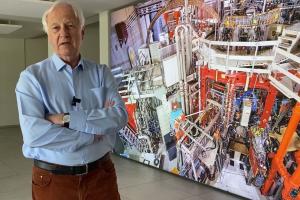H-mode, the discovery that made ITER possible
Forty years ago, the scientists in the ASDEX tokamak control room at the Max Planck Institute for Plasma Physics (IPP) in Germany sat up straight. Something new had happened during what was expected to be a routine day of experiments ... a never-before-seen state of the plasma, which would later come to be called H-mode, for "high confinement." When shared with the world plasma community, some thought at first that it must be a measurement error ...
Thursdays were experimental days on ASDEX. On this particular Thursday, in February 1982, there was nothing to indicate that history would be made. A series of neutral-beam-heated discharges was planned, and scientists expected to confirm what they had seen before—that these plasmas had the advantage of being extremely reproducible, but the disadvantage of quickly degrading confinement.
But suddenly, there was a dramatic change across all plasma parameters. As the plasma in ASDEX was exposed to intense heating by the neutral beam, its confinement suddenly improved by a factor of two and the turbulence at the plasma edge all but disappeared.
"All the scientists in the ASDEX control room realized that something extraordinary had happened," recalls Friedrich Wagner, who was responsible for this area of research at ASDEX at the time.
This unexpected transition from L-mode ("low-confinement," where confinement could not be sustained) to improved H-mode—a development that was soon reproducible in tokamaks around the world—changed the game, influencing tokamak design and opening the door to a project like ITER.
"The discovery of the H-mode is what made ITER possible in the first place," says Elisabeth Wolfrum in an article published by IPP to mark the anniversary of the discovery of H-mode. "Through H-mode research, we are getting closer and closer to plasma operating states that are most suitable for large fusion facilities like ITER."
The now-emeritus H-mode discoverer Friedrich Wagner is excited about the completely new possibilities that the fusion facility in southern France will offer once it is completed. "ITER will be an instrument like we've never had on Earth before." From his work on ASDEX—and especially from the H-mode year 1982—he has learned one thing: "Progress does not always develop linearly. In between, there are completely unexpected big leaps forward. That's what makes science so exciting."
Read the full article on the IPP website in English or in German.
See Friedrich Wagner tell the story of the discovery of H-mode in this 22-minute video.


